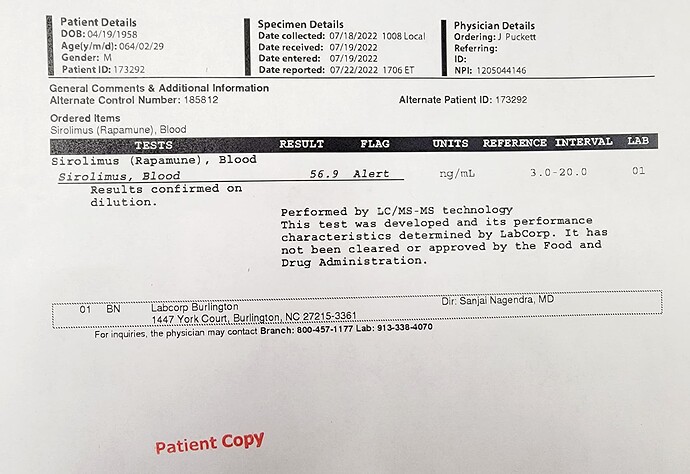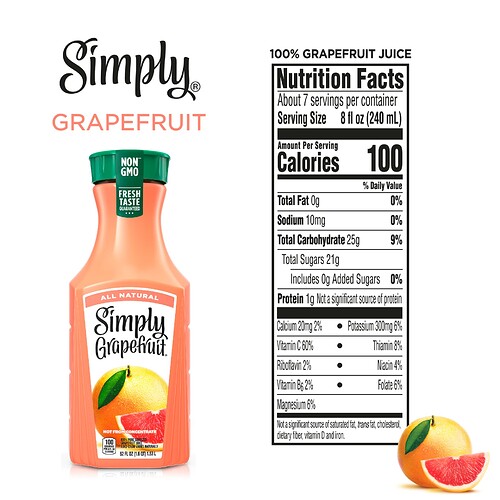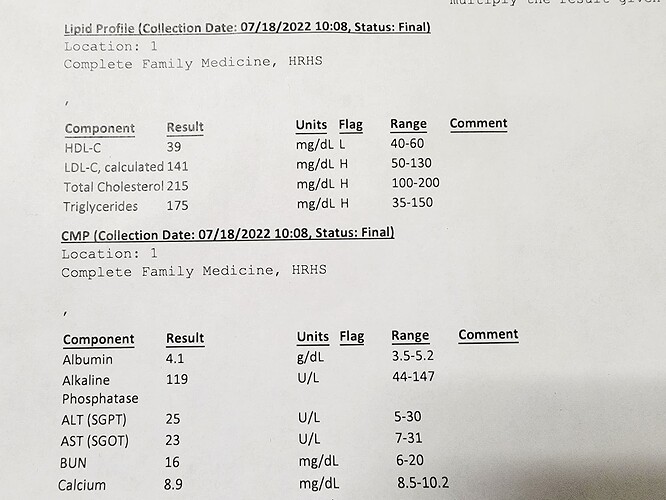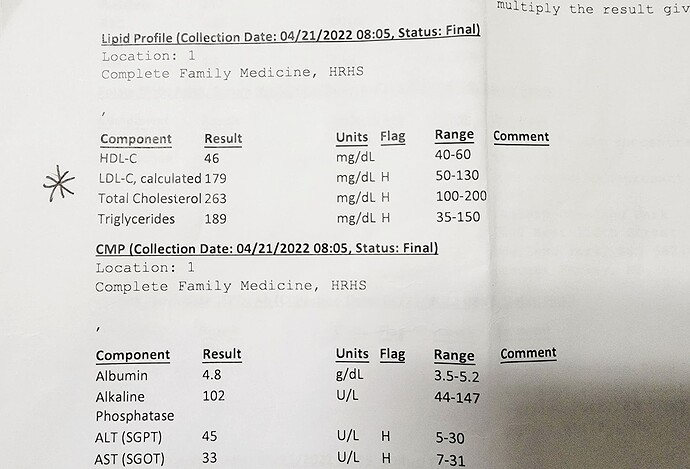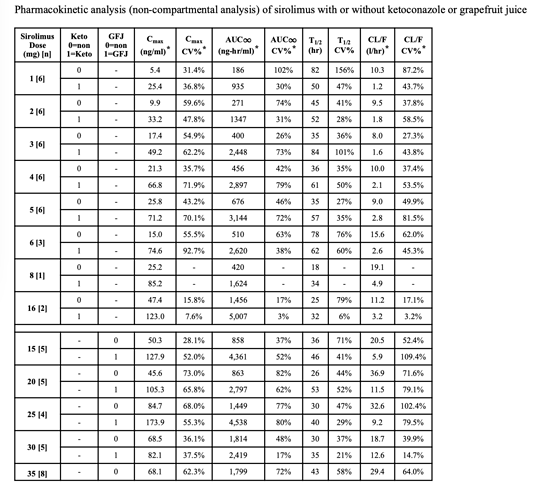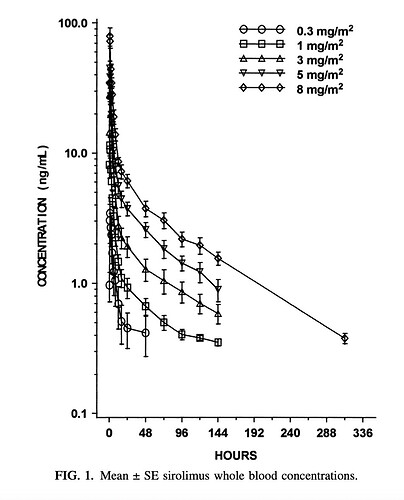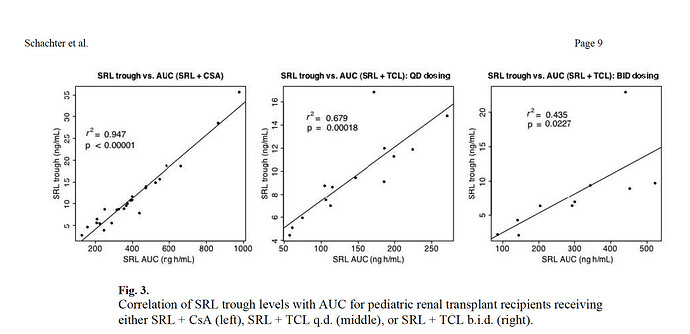I take my rapamycin with a can of sardines to get the high fat benefits of increased bioavailability.
So then I should take it with my EVOO in the morning. ![]()
Yes - with the rapamycin in the morning (for those of us who find late-day rapamycin tends to hinder sleep).
I have developed a weird side effect. Meat and eggs nauseate me.
Hmmm… I would think Grapefruit would be nauseating at that point. Lol.
I use to do that much Grapefruit and really messed with my digestion and puked.
Now going with 8 mg Rapa and just an 8 ounce of GFJ chaser… when I take the pills. Will have the results of that combo effect from a LabCorp test on Monday… will report here.
Actually, I really enjoyed the grapefruit. It was pink, so it tasted much better IMHO.
I kind of got a real surprise on my LabCorp Sirolimus/Rapamycin blood test. My blood was drawn 3 hours after taking 4 pills of sirolimus at 2mg each = 8mg total and 1 cup which is 8 ounces of Simply Grapefruit juice.
Figuring at 8mg Sirolimus with a 3.5 multiplication by the Grapefruit Juice - I anticipated 28ng/mL.
In reality I got a 56.9 ng/mL reading and an Alert from the LabCorp to my physician. He notified me to stop taking sirolimus until I get to 20 ng/mL.
I had not expected a multiplication factor of 7 on such a small amount of GFJ which I literally took to wash down the four 2mg pills. So a heads up to everyone taking GFJ to extend their medication and get a higher dose in the blood. You can’t know what your blood level of sirolimus is unless you actually test yourself. In my case, I tend to run higher – no wonder I couldn’t sleep for two days and the diarrhea. LOL. I was lookingfor my peak. So good to do a test to know where you are at.
I will see my physician in 2 weeks and explain what happened. So tonight is my rapamycin night after gym… I might be able to take just 2 pills and the Grapefruit Juice to hit my 20+ goal. When I see him in 2 weeks… I will do a blood draw on 2 pills and GFJ and prove to him I am keeping it around 20 ng/mL
Awesome!!!
You didn’t do a trough, might want to do next time.
Not so fast on your advice…we are all n=1 and have huge inter person variation along the entire gastro pathway.
You only measured a quasi peak…NOT trough. Trough is what matters. Therapeutic trough is 5-15, that’s why you got alert…the labs are linked only to cancer/transplant patient monitoring.
My advice, do a full proper blood test at current regiment and then reflect.
What about your lipids…expect to be same as past, you are same rapa protocol as last lipids?
I would look at entire side effect profile before massive change.
Yes - you are correct MAC - Just saying my multiplication is 7 not 3.5 with just a small amount of GFJ taken simulataneously with the medication. So who knows what each individual is actually getting.
You don’t know if you don’t test yourself. Glad I did.
As too lipids - still high/above normal - but LDL-C was lower than last time by about 20 points. Remember despite a high LDL-C my CAC is zero - no calcium in my scan.
Comparison of lipids 3-months ago and now.
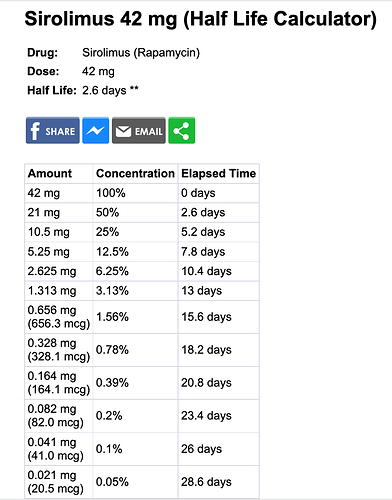
At most I would have 5mg at trough still in my system from the previous week’s dose.
Actually, I have the full blood regiment (4-pages) and everything is high optimal or middle normal. No surprises or issues.
I repeat you have different gastric, intestinal and liver enzyme genes. When they look at a specific cancer patient, they also screen mTOR genes if they are going to use a rapalog as part of the cocktail.
Share some insight if you can if your lipids and CBC and glucose are any different, if you can do a clean before/after.
Next time you must do a trough before going rocket ship.
Yeah, that’s partly why I don’t use GFJ and always become wary of it - especially without CLIA-certified whole genome sequencing and such supervised by a pharmacogenetics pharmacist expert and physician - but I can understand cost issues
Help me out here, what in the world made you think that you can simply add up the mg of sirolimus taken and it will be equal to the ng/ml in your blood? 8 * 3.5 = 28, but why would that be the concentration in your blood? Am I doing this wrong? Is there a reason?
The seminal cancer/rapa/GFJ study showed taking GGJ to block CYPA34 liver enzyme (and likely intestinal enzymes), “on average” raised AUC by 350%, or 3.5…but this does not necessarily mean Cmax correlation, very different (which is what Agetron quasi measured, since it was a single time point, not necessarily the true peak, as the peak is somewhere between 1-3 hrs). See image below.
“Rapamycin undergoes extensive hepatic and intestinal metabolism via CYP3A4 and CYP3A5, as well as excretion by P-glycoprotein. One potential strategy to increase bioavailability of rapamycin is co-administration with CYP3A inhibitors such as grapefruit juice, exerting an effect predominantly on intestinal enzymes”
If you look at chart and Cmax, 15 mg, it went from 50.3 to 127.9 ng/l, with and without GFJ, or 250%.
You cannot do apples to apples, looking at a “juiced” rapamycin dose and half life table. The Cmax and AUC have been altered, you cannot “assume” you took the equivalent of a 42 mg dose.
This is why you must actually do the trough blood test next time.
When I did a peak test and it came in much higher than I expected, my question was: how does mg in the dose relate to ng/mL in the blood? Looking at MAC’s table, it doesn’t seem to be a one to one correlation.
The higher the dose, the higher the concentration in ng/mL. But the pharmacokinetics are more complex, highly NON-LINEAR, as the drug absorbs into bloodstream, and diffuses/clears from the tissues/system.
This is why you must test trough at minimum while experimenting with rapamycin.
Trough DOES correlate with AUC linearly, which is the quasi only therapeutic metric of relevance (side effects aside).
What Bicep said. Different people absorb differently, we know that. But that aside, if one mg with grapefruit juice equals three and a half mg, why would we think that would equal three and a half ng/mL?
Mg and ng/mL aren’t the same measurement.
You are correct. The confusion began with the 350% GFJ boost being applied to mg or ng/L, when it applies to AUC.
Thanks Argonaut. After reading what I wrote, it sounded abusive instead of what I wanted. I just assumed I didn’t know what was going on. I didn’t mean to rant but obviously ng/ml in blood is a moving target. It goes up for 4 hours, then down for 14 days. Mg consumed is like how much you load into the cannon.
A paper I read a few months ago talked about how people taking Rapa had bad lipids until their trough was less than 15. I think. Can’t find that paper now. I need better organization.
I got my tests today, so I will soon have tests to share as well. I’m going 4 hours in, then 13 days later. The trough measurement is the important one.
See, you are now a real pioneer! ![]()
![]()
![]()
Not advice to anyone!:
But, hey, Dr. B. probably loves you, me too. ![]() You are basically following his protocol.
You are basically following his protocol.
Your results indicate to me that I might add another day between doses.
Certainly not going to get my rapamycin levels tested. I am a results-oriented person and don’t give a hoot about anything but my normal blood and age-related markers, and how I feel.
I have already been given the boot by my cardiologist. He immediately dropped me and gave me a referral to another cardiologist for merely wanting to discuss rapamycin with him.
A notice from LabCorp would give my primary provider a heart attack and he would ask me: What the hell do you think you are doing? No, I don’t discuss anything with my primary provider outside of the tests he prescribes. But, still, he is a good man and has my best interests at heart.
As far as I know, no one has died from an overdose of rapamycin or suffered any serious irreversible side effects. If they have it’s an incredibly low number considering this drug has been around for decades.
Frankly, I prefer risk takers to " nervous Nellies’"
Sept. 19, 2005 – People who enjoy taking risks may be more content and satisfied with their lives.
A new study shows that a willingness to take risks is not only linked to personal satisfaction, but it also may be related to a person’s age, sex, and even their height.
“Why Risk Takers Do Better in Business and in Life. Playing it safe often isn’t in your best interest. Here’s why”
Contrary to popular belief, risk-taking behavior can be healthy and help young people thrive. Many adults think of risk as a bad thing. There are certainly negative risky behaviors such as substance use, stunts that can result in serious injury, texting while driving and unprotected sex.
Therapeutic chronic dose monitoring can be as low as 5 ng/mL trough, showing lipids dysregulation, and highly individual response.
Don’t assume, surmise…measure. Then you can manage.
.
